Laptop Mag Verdict
Motorola's supersized Droid has a gigantic display, excellent touch keyboard, and an impressive high-def camcorder with HDMI output.
Pros
- +
Bright, massive display
- +
Responsive and very accurate keyboard
- +
Loud and clear speaker
- +
HDMI output
- +
Blockbuster app for renting, buying movies
Cons
- -
Interface occasionally stutters
- -
Phone might be too large for some
- -
No front-facing camera
Why you can trust Laptop Mag
Did you think Verizon was going to let Sprint hog all the Android glory with its HTC Evo 4G? Heck no. Verizon's newest flagship device, the Droid X, was built to go head-to-head against Sprint's superphone, not to mention AT&T's finely polished iPhone 4. The Droid X has a massive, vibrant 4.3-inch WVGA (854 x 480) display, Android 2.1 with splashes of an updated Motoblur interface; a speedy 1-GHz processor; and 8GB of on-board storage. Still not enough? How about a full multitouch QWERTY keyboard that has taken the crown as the best for an Android device, plus the capability of serving as a Hotspot for up tofive devices? It doesn't have 4G, and the Motoblur interface (while tamer than the original) may confuse some. But for Verizon Wirelesscustomers this is an Android lover's dream come true.
Design
The Droid X is unapologetically large and boisterous, yet svelte at the same time. Its size is deceiving in a good way. Measuring 5 x 2.6 x 0.4 inches, the Droid X is longer but slimmer than the Evo 4G, which measures 4.8 x 2.6 x 0.5 inches.At 5.5 ounces, it's also half an ounce lighter than the Evo 4G. The Droid X brings back four physical Android buttons (Menu, Home, Back, and Search) beneath its massive screen--a contrast to the capacitive, touch-sensitive buttons found on the Evo4G(see image below). The tactile feedback of the Droid X's physical keys means it's less prone to accidental input than the Evo 4G's buttons, which tend to be a bit more sensitive.
For some, it may seem a bit awkward at first holding the larger Droid X to your ear when making calls, but it's a matter of preference; we didn't mind at all. The top back of the phone has a slightly protruding hump that curves where the camera lens and LED flash are located,providing a nice resting position for your pointing finger when held. While slightly longer than the Evo 4G, its thinner profile will make tucking it into a pocket relatively easy, although it may be a tight fit for some.
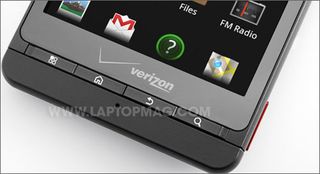
Click to enlarge
Above the Motorola logo atop the display is a slim speaker, and beneath the physical Android buttons is the microphone opening. There are two additional microphones for noise cancellation that improve the Droid X's call quality: one is located on top of the device, left of the 3.5mm headphone jack and power/lock button, while the other is located on the lower back. Easily adjustable volume controls are on the right, and there's also a dedicated camera launch/shutter button, something both the Evo 4G and iPhone 4 lack. To the left is a mini HDMI port (cable sold separately), and a microUSB port. An 8-megapixel camera lens is located on the rear, coupled with an LED flash.

Click to enlarge
The charcoal black back cover on the Droid X doesn't sport the golden grillof the original Droid; instead, the phone's matte finish completely covers the back, giving it a cleaner appearance. The front of the phone also looks sleek, with the large display taking up most of the area, and the surrounding bezel kept to a minimum. Unlike the Evo 4G, the Droid X does not include a built in kickstand, but an optional charging cradlethat positions the device upright and enables it to output HDMI to external sources will be available for $49.99.
Display and Audio

Click to enlarge
With 4.3 inches of real estate and a resolution at 854 x 480 (WVGA), images looked superb on the Droid X. Its sharpness, while not as dense as the display on the iPhone 4 or Droid Incredible, still produced excellent video clarity when playing back the 720p HD video we captured while out and about in NYC. Video content from the pre-installed Blockbuster application looked crisp as well, and better than on the HTC HD2 (which has the same app).
The external speaker on the Droid X was loud and clear, with an impressive volume that'sdistinguishable even when you'rea couple feet away from the device. We didn't notice any apparent distortion when cranking the volume up during a conference call,nor while listening to some streaming tunes on Pandora. The speaker really came in handy when getting turn-by-turn voice directions from Google Maps Navigation.
User Interface and Web
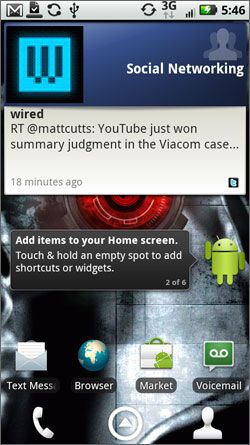
Click to enlarge
The Droid X runs Android 2.1 with a revised version of Motoblur, Motorola's custom user interface. Motoblur has been seriously toned down, which is for the better in our opinion. Instead of throwing every single social status update and RSS feeds to you all at once in various bubbles across several screens (which can become overwhelming in phones like the Motorola Cliq XT and Backflip), the Droid X keeps itsimple with a pair of widget bubbles on a single home screen that extract the exact social networking content you choose.
Like HTC Sense, Motoblur gives the Droid Xits own custom widgets in addition to the standard widgets with stock Android. The multimedia widget is particularly cool; it has a preview window, and a right button that allows you to instantly view the media gallery, or simply press the left button to launch the camera.
A total of seven home screens can be customized with widgets, folders, applications, and shortcuts. We especially appreciate that the Droid X gives you the ability to customize widget size. For example, when we enlarged a favorite contact's photo on one screen, we could see the option to dial them with a tap or get their latest social networking update. Motoblur isn't quite as elegant as HTC Sense, but it's no ugly duckling, either.
A useful new feature is the Mac OS-like dock/navigation bar that allows you to scroll through any application, widget, folder, or anything you've placed on a home screen without having to actually swipe over to that screen. This feels like Motoblur's answer to HTC Sense's thumbnail view, giving you fast access to each home screen.
Keyboard
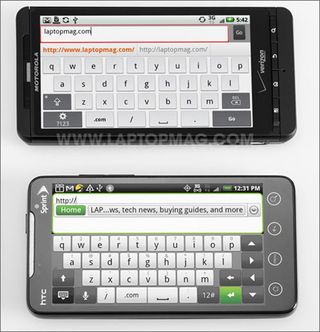
Click to enlarge
Whether typing fast or slow, the keyboard on the Droid X is well executed; it's easily the best Android virtual keyboard by far. The Droid X gives you two options, a full multitouch keyboard (two characters will register if the keys are pressed simultaneously), and a secondary Swype keyboard. The multitouch keyboard is excellent; its keyboard is large, thanks to the extra screen real estate. Key presses registered quickly and accurately, and the haptic feedback was subtle, but effective. The Droid X sets the standard for how a virtual keyboard on Android should perform. While we're fond of Swype, we found ourselves using the new multitouch keyboard more. The space bar is oddly positioned on the Swype keyboard in landscape mode.
Performance
The Droid X has some serious tech beneath its hood. Powered by a 1-GHz Texas Instruments OMAP3630 processor, 512MB of RAM, and 8GB of storage (24GB including the 16GB microSD Card), the Droid X has the goods on paper that translate to a generally smooth user experience.
In terms of raw performance numbers, the Droid Xbested the Evo 4G (which has a 1-GHz Qualcomm Snapdragon processor) across the board. In Linpack for Android (which measures a system's floating point computing power), the Droid X scored 8.2 megaflops to the Evo 4G's 6.7. Using the generically named Benchmark test, the Droid X scored 31.5 in the graphics section, compared to 27.8 for the Evo 4G. For the CPU portion, the Droid X's score was 777.9; the Evo 4G's was 649.7. Lastly, in the memory part of the test, the Droid X scored 424.3 to the Evo's 312.9.

Click to enlargeAnecdotally, the Droid X was fast but not without fault. Switching in and out of applications was lag-free, and animations in EA Games' The Need for Speed Shift game looked exceptionally smooth. However, occasionally when moving between home screens there was a noticeable moment of lag. Stuttering really reared its ugly head when swiping to unlock the device; the swiping gesture was totally jerky. Also, live feeds stuttered a bit when recording video, and we noticed an occasional camera stutter when snapping images. Hopefully these issues will be addressed before or soon after launch.
Web and Connectivity
The custom browser on the Droid X was speedy, and renders pages every bit as good as the Evo 4G. The visual bookmark gallery, which places saved bookmarks into a coverflow-esque gallery, is a nice touch. Gestures like pinch-to-zoom work without a hitch. We loaded CNN's mobile site in 5.9 seconds via 3G, and 3.1 seconds using the Droid X's 802.11b/g Wi-Fi.
As we've usually seen, Verizon Wireless' 3G network was noticeably strong. We downloaded the 1.5MB Google Sky Maps application from the Android market in 13.1 seconds. Using the Speedtest.net app, we experienced blazing download speeds of 1.1 Mbps and 765 Kbps on the uplink.
Mobile Hotspot
The Droid X's mobile hotspot worked with our notebooks and iPad easily, but it's a toss-up as to whether it has the advantage over the Evo 4G. The Droid X hosts less devices (five to the Evo 4G's eight) and lacks 4G capabilities, but it has a broader 3G network. Droid X owners will pay an additional $20 a month for the hotspot feature (for 2GB), whereas Evo 4Gcustomers have to cough up $30.
E-mail and Messaging
Gmail setup was fast and easy, as it is on all Android devices. Setting up a Yahoo account was just as simple; we didn't have the same configuration issues with the Droid X as we did on the HTC Aria. However, we continue to dislike that the Gmail app and e-mail app are separate and have two different interfaces. Exchange support is also available, and additional Enterprise support will be available late summer when the Droid receives its Froyo (Android 2.2) update. SMS worked well, and Motoblur organizes contacts better than stock Android. Google Talk worked exceptional too.
Camera and Camcorder

Click to enlarge
Like the Evo 4G, the Droid X has an 8-megapixel camera that took good pictures in daylight. We went around Manhattan, shooting moving traffic, billboards, and buildings; the Droid X took clear images, although shutter refresh speeds lagged once or twice. In low-light conditions, the Droid X takes grainy photos unless you use the flash. The iPhone 4's 5-MP camera delivers less detail but brighter photos without a flash.

Click to enlarge
Also like the Evo 4G, the Droid X's camcorder records 720p video; this too worked well, though we couldn't help but notice the slow motion on the display versus what we were shooting in real time. Playing the video back on the display was fine, however. Indoors, we noticed a lot more noise in the footage than outdoors, but the quality was still acceptable.
Apps
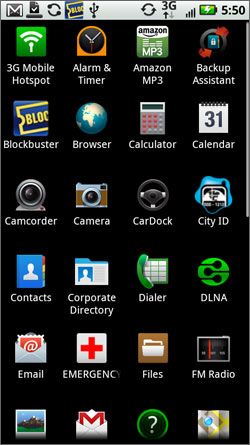
Click to enlarge
In addition to Verizon's V Cast service, there are a host of applications that take advantage of the Droid X's processing power and display, such as NFL Mobile, Skype Mobile, The Need for Speed Shift, and Blockbuster On Demand. These are additions to Google's own fleet of services such as Latitude, Search, YouTube, Calendar, and Android Market. Like all Android devices, Amazon's MP3 online music store is also present.
While still less than half the size of Apple's App Store, the Android Market now has over 65,000 apps, and is showing no signs of slowing down. We're hoping that Google will implement carrier billing in future versions of Android, as it would take the hassle out of setting up a personal account to access premium content.
GPS
Google Maps Navigation is a free and robust navigation app that puts many standalone GPS devices to shame. Getting from point A to B was as simple as typing in the entire address; Google Navigation offers turn-by-turn directions, and even a street view option to show you precisely where you're heading. It just works.
Music and Video
The Droid X's music player is stock Android, and plain compared to the Sense player on the Evo 4G. Pandora, a free music streaming app (and arguably the best), worked with no problem, and sounded good through the Droid X's external speaker.
As mentioned above, video applications such YouTube and the Blockbuster app really take advantage of the large display; movies looked superb, and content loaded considerably quick, especially over Wi-Fi. Too bad the Blockbuster app does not work with the HDMI output, only content that you capture.
Accessories
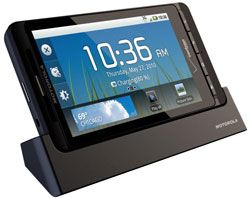
Click to enlarge
At launch, consumers will be able to purchase a host of accessories for the Droid X. A six-foot HDMI cable will retail for $24.99, while a charging cradle will go for $49.99. A vehicle mount useful for using the Droid X as a GPS device will run you $39.99; a dashboard app with navigation, music, voice search, and internet radio will automically appear on the Droid X display when plugged in to the mount.
Call Quality and Battery Life
Verizon's 3G network delivered strong reception when we made a call to the West Coast, and we didn't experience any dropped calls. Even in places where other carriers would not have a signal, such as in the NYC subway station, we were able to dial out with good clarity on the Droid X.
Verizon estimates that the Droid X should last for 8 hours of talk time and 9.2 days on standby. We were able to get through a full day of making calls, surfing the web, and playing games, and had more than a quarter bar ofbattery left the next day. We will have an update once our final battery tests are completed.
Price and Value
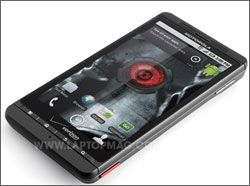
Click to enlargeThe Droid X costs $199 with a two-year contract after a $100 mail-in rebate. A $69.99 voice plan gives you unlimited calling to any mobile carrier, plus $29.99 for unlimited e-mail and web data. If you the spring for the $20 mobile hotspot feature, the total would be $120 a month. That sounds steep, but it's the same amount per month as a similarly equipped HTC Evo 4G (if you sign up for the same services).
Verdict
With its huge and responsive screen, sharp 8-MP camera, and mobile hotspot feature, the $199 Droid X can rightfully take its place as Verizon's top Android device. Some may prefer the more compact Droid Incredible, but it doesn't offer HDMI output or 720p video recording. While this device likely won't sway Sprint customers away from the Evo 4G, especially if they live in a city with 4G coverage, Verizon Wireless power users will find that the Droid X marks the spot.
Motorola Droid X Specs
| Audio formats supported | eAAC+, AAC+, AAC, WAV, MP3, MIDI |
| Bluetooth Type | Bluetooth 2.1 EDR with A2DP |
| Brand | Motorola |
| CPU | 1-GHz Texas Instruments OMAP |
| Camera Resolution | 8 MP |
| Carrier | Verizon |
| Company Website | http://www.motorola.com |
| Data | EV-DO Rev. A |
| Display (main) | 4.3 inches/854 x 480 |
| Form Factor | Candy Bar |
| Internal Memory | 8GB |
| Memory Expansion Type | microSDHC |
| Networks | CDMA 800/1900 |
| Operating System | Android 2.1 |
| Ports | microUSB, HDMI, 3.5mm headphone |
| RAM | 512MB |
| Size | 5 x 2.6 x 0.4 inches |
| Talk / Standby Time | 8 hours/9.2 days |
| Video formats supported | MPEG-4, H.264, H.263, WMA |
| Weight | 5.5 ounces |
| Wi-Fi | 802.11b/g |
